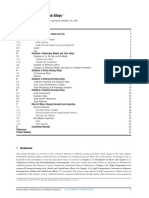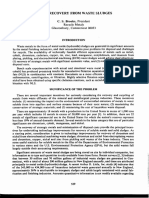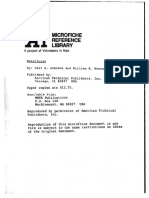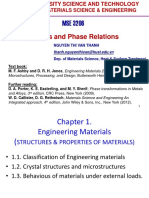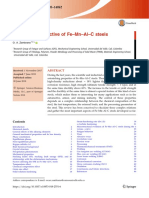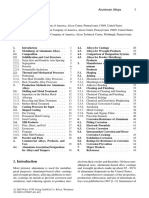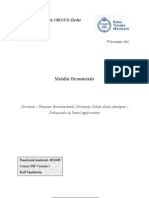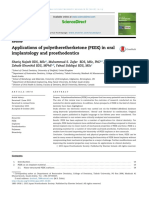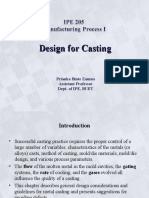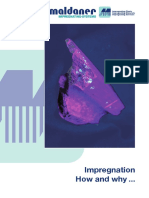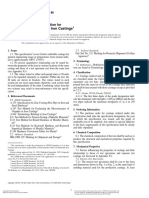Professional Documents
Culture Documents
The Metallurgy of Ni-Cr Alloys For Fixed Prosthodontics
Uploaded by
Arushi AgarwalOriginal Description:
Original Title
Copyright
Available Formats
Share this document
Did you find this document useful?
Is this content inappropriate?
Report this DocumentCopyright:
Available Formats
The Metallurgy of Ni-Cr Alloys For Fixed Prosthodontics
Uploaded by
Arushi AgarwalCopyright:
Available Formats
The metallurgy of Ni-Cr alloys for
fixed prosthodontics
G. R. Baran, Ph.D.*
Temple University, School of IIentistry, Philadelphia, Pa.
B ase metal a.lloys currently account for a sizable
portion of the fixed prosthesis alloy market.’ The low
Table I. Ni-Cr alloys and manufacturers
Allov Manufacturer
price of these alloys is their major attraction, although
this advantage can be offset by inexperienced handling Jelbon, Triumph, J. F. Jelenko, Armonk, N.Y.
of the alloys.2 Elxpecting base alloys to behave as the Omnicast
Rexalloy, Rexillium III Rx Jeneric, Wallingford,
noble metal alloys, that is, in casting, finishing, and Conn.
porcelain application, is often cause for failure.’ Ceramalloy, Ceramalloy II Johnson and Johnson,
Large differences in physical properties and han- Windsor, N.J.
dling exist among the various brands of base metal Litecast, Litecast B Williams Gold and Refining
alloys. The metallurgical differences among alloys and Co., Buffalo, N.Y.
Wiron S, Wiron 77 BEGO, Bremen, West
how they affect manipulation and use of the alloys will Germany
be considered. Relationships among composition and Biobond Dentsply International,
microstructure, mechanical properties, handling, and York, Pa.
indications for these alloys will also be reviewed. Neydium NP J. N. Ney Co., Bloomfield,
Conn.
COMPOSITION AND MICROSTRUCTURE Gemini II Kerr Mfg. Co., Romulus,
Mich.
Two main classesof base metal alloys are the Ni-Cr Ultratek Ultratek International Inc.,
system and the Co-Cr system. The Co-Cr alloys were Concord, Calif.
developed in response to fears about possible dermato- Unibond Unitek Corp., Monrovia,
toxic effects of alloys containing nickel or beryllium. Calif.
Microbond NP/2 Howmedica, Chicago, Ill.
However, because far more nickel-based alloys are Ticonium Corp., Albany,
Ticon
available than cobalt-based alloys, this article will focus N.Y.
on the Ni-Cr alloys.
The binary phase diagram for the system Ni-Cr
shows extensive solid solubility of chromium in nickeL4 copper, beryllium, and traces of the rare earth ele-
As a resuh, the binary alloys are not precipitation ments. Elements contributing to solid solution
hardenable. Approximately 37 wt% Cr may remain strengthening include aluminum, tungsten, and molyb-
dissolved at room temperature in the matrix called denum.5 Additions of carbon, boron, silicon, and alumi-
gamma. Alloying elements are needed to strengthen the num are known to stimulate precipitate formation,
Ni-Cr alloys. Chromium provides corrosion resistance some of which are complex carbides such as MC, M,C
and some solid solution hardening, while other addi- and M,,C, (where M is a metallic element); nickel
tives are used to provide more solid solution hardening silicides; and the gamma-prime phases exemplified by
or precipitate formation. The presence of alloying the compound Ni,Ak6-” Boron, which occurs mostly at
additions is responsible for differences in castability, grain or dendrite boundaries, markedly reduces the
mechanical behavior, and oxide formation. solubility of carbon, thereby stabilizing the formation
Common alloying elements present in amounts of carbides9 The element niobium (columbium) is
ranging from less than 0.1% to 14% include carbon, helpful in the air-melting of nickel alloys.1° Boron and
boron, aluminum, niobium, molybdenum, tungsten, silicon have been used as deoxidizers and fluxing
iron, manganese, gallium, tin, titanium, cobalt, silicon, agents to improve castability.” Boron, gallium, and
beryllium are effective in lowering the melting point of
the alloy.4 The rare earth elements, as well as tin and
*AssociateProfessor. Departmentof Operative Dentistry. gallium, control oxidation of the alloys during porce-
THE JOURNAL OF PROSTHETIC DENTISTRY 639
BARAN
Table II. Approximate compositions of Ni-Cr alloys (in weight percent)
Rexillium Microbond
Ultratek Litecast B Gemini II Ticon III Wiron S Wiron 77 Neydium NP/2 Ceramallov Biobond
Ni 80 77 80 70 76 69’ 68 79 76 67 76
Cr 11 12 12 16 13 17 20 11 14 20 12
MO 2 ‘4 2 4 X 5 6 4 5 6 3
Nb 1.5 3.2
Al 2 X 3 4 X 1.8
Si 0.5 X 0.42 4 1 4 X
B 3 X
Fe 2 X 0.13 0.75 0.37 0.05 0.12 X
Ti 0.02 0.01 X 0.02
Sn 0.01 X
co 0.5 0.92 0.42 0.01
C 0.02 X 0.2 0.03 X 0.04 0.04 0.09 0.02 0.02 X
cu 0.005 O.!l
Mn 0.02 4 3
Ga X
Be 1.6 1.7 2.1 0.48 X
W 0.65
Pd
X = Element known to be present, but exact amount uncertain. ? = Presence of this element is expected. More information can be obtained from
references 8, 15, 22, 27, 29, 79, 97, 98, and 108 and from the manufacturers.
Table III. Selected mechanical properties of Ni-Cr alloys
Alloy Yield strength Tensile strength % elongation DPN Formability
Ultratek 85,700 165,600 24 293 6,607
Gemini II 100,800 160,600 11 340 -
Litecast B 117,000 - 12 330 -
Rexillium III 100,000 155,000 11 254 8,693
Omnicast 70,000 1J0,000 10 240 -
Wiron S 90,000 102,400 6 315 -
Wiron 77 63,191 102,056 - - -
Jelbon 124,400 128,100 1 436 7,054
Neydium 78,700 101,900 3 316 6,300
Rexalloy 37,000 65,000 11 155 2,625
Microbond NP / 2 37,700 78,300 27 175 3,048
Ceramalloy 75,400 127,400 4 344 -
Ceramalloy II 44,000 90,000 6 200 4,361
Biobond 58,000 75,000 6 - 4,435
Triumph 75,000 90,000 250 -
Litecast 44,700 87,200 28 175 3,624
Properties are presented for the as-cast condition. Yield strength is at a 0.2% offset. DPN = Diamond pyramid hardness number. Formability is
defined as the quantity of inch-pounds per unit volume needed to permanently deform the alloy to a 5% strain. For more information, see references
22 through 29 and the manufacturers’ technique manuals. All values are subject to normal statistical deviations.
lain firing. l2 Some work has also been done on experi- noble metal alloys. The dendritic structure is accompa-
mental alloys containing significant amounts of vanadi- nied by compositional segregation evident in the micro-
um.13 Table I lists alloys discussed in this report and structure of alloy specimens treated with certain
their manufacturers. Table II lists the composition of etchants.15The microstructure of nickel casting alloys
these alloys. is defined during solidification and remains relatively
On freezing and solidification, Ni-Cr alloys posessa immune to heat treatments encountered during dental
dendritic morphology.‘? For this reason it is ermneous laboratory processing. W” HoweGer, the alloys may
to compare the “grain size” of these alloys to that of soften after porcelain baking, although reasons for this
640 NOVEMBER 1983 VOLUME 50 NUMBER 5
NICKEL-CHROMIUM ALLOYS
bon, and Wiron 77 have extensive precipitates with
occasional eutectic-like shapes that are well distributed
Ceramalloy
throughout the alloy.
Litecast Unibond Triumph II
Precipitate particles can assume another morphology
68 64 38 73 in alloys such as Ceramalloy II, Neydium NP, and
16 22 24 18
Wiron S (Fig. 1, J to L). They are located at dendrite
14 9 ? 4
boundaries and contain large fractions of the alloying
X ? X elements. Biobond precipitates can assume a blocky,
X ? X isolated morphology (Fig. 1, M). Unibond contains
X little precipitate (Fig. 1, N>, The alloy Triumph
7 X
contains significant amounts of palladium and shows a
large volume fraction of a phase presumingly rich in
beryllium or palladium (Fig. 1, 0).
X X X The identification of the secondary phases in all
alloys except beryllium poses a challenge. Some sec-
X
ondary phases are complex carbides, but there is
2 disagreement on which form. Some investigators
believe the carbides to be M2$6.20~2’ Because M2$Z6
20 carbide forms as the result of heat treatment, it is more
likely that these phases are of the MC variety.22
Neither the type of carbide nor the presence of the
softening are not clear. Homogenization may occur and expected gamma-prime precipitate has been conclu-
be responsible for the changes in hardness and ductility sively determined.
or coarsening of finely divided gamma-prime may take
place, allowing greater freedom for dislocation move- MECHANICAL AND CHEMICAL
ments between the more widely spaced precipitates5s” PROPERTIES
Proof for either of these hypotheses or other explana- Mechanical properties
tions is lacking. Through the American Dental Association testing
There are similarities among the microstructures of program of dental materials and devices, mechanical
commercially available alloys. The alloy photomicro- properties of various alloys are available to interested
graphs shown in Fig. 1 can be divided into several clinicians and technicians. This type of testing may
groups, and the most obvious of these are alloys easily be performed by a laboratory equipped with
containing beryllium (Fig. 1, A to C). These are the rudimentary metallurgical testing equipment. Me-
only alloys with a large volume fraction of a solid chanical properties have been tabulated for publica-
solution as a secondary phase. Similar alloys were tion, and alloy manufacturers commonly provide such
among the first of the base metal alloys commercially data on alloy containers. 23-2*Table III lists mechanical
available for fixed prosthodontics.18~19 The alloys con- properties of some commercially available Ni-Cr
taining beryllium are marked with the presence of a alloys.
solid solution with the composition NiBe located The significance of these properties has not been
between dendrites of the gamma primary solid solu- explained. Commonly quoted properties include hard-
tion. Examples of such alloys are Rexillium III,, ness, yield strength, tensile strength, and ductility,
Litecast B, Gemini II, and Ultratek. expressed as percent elongation. The two most popular
Another group of alloys is characterized by a low methods of measuring hardness of dental alloys are the
fraction of precipitates (Fig. 1, D to fl. These alloys, Brine11 hardness test and the Vickers hardness test.
represented by Rexalloy, Litecast, and Microbond The Brine11 hardness number is approximately 10%
NP/2, contain large dendrites of the matrix phase with lower than the Vickers hardness number. However,
a thin, ribbonlike precipitate sometimes occurring at because of the difference in indenter size and geometry,
dendrite boundaries. The secondary phase in Micro- the Vickers test cannot provide an average uniform
bond NP/2 resembles the product of a peritectic hardness reading in a multiphase alloy.29 For a multi-
reaction. A peritectic is in fact found in the Ni-Ga phase alloy, the larger Brine11 indenter can provide an
system. Other alloy groups contain precipitates that average hardness, as it has a greater probability of
differ in morpholqgy. In one group, Ceramalloy, Jel- encountering several phases simultaneously during
THE JOURNAL OF PROSTHETIC DENTISTRY 641
BARAN
Fig. 1. As-cast microstructures of several Ni-Cr alloys. Markers represent 50 pm. Alloys
are A, Ultratek; B, Gemini II; C, Rexillium III; D, Rexalloy; E, Microbond NP/2; F,
Litecast; G, Ceramalloy; H, Jelbon; I, Wiron 77; J, Ceramalloy II; K, Neydium NP; L,
Wiron S; M, Biobond; N, Unibond; and 0, Triumph.
642 NOVEMBER 1983 VOLUME 50 NUMBER 5
NICKEL-CHROMIZJM ALLOYS
testing. It is therefore not appropriate to compare Studies have also been made of the sag resistance of
hardness readings between single-phase and multi- alloys during porcelain firing. Ni-Cr alloys deformed
phase alloys.30 less at the high temperatures associated with porcelain
When yield strength is calculated, it is proper to fusion than did noble metal alloys.40
refer to the amount of offset when making the measure- Current research of the properties of alloys deals
ment. The value of 0.2% is used frequently. However, with establishing a compatibility index that would
there is no clinically related evidence indicating that a indicate which alloys perform best with a given porce-
0.2% offset is more significant than a 0.1% offset. The lain. It has always been assumed that the thermal
implication is that the relationship between yield coefficient of expansion of the alloy needs to be slightly
strength calculated at various amounts of offset is the higher than that of the porcelain to prevent the buildup
same for all alloys. Proof to the contrary was offered by of potentially destructive tensile stresses at the metal-
Morris and Asgar,3’ who studied the yielding behavior porcelain interface. 26 While standards for expansion
of partial denture alloys. The relationship between coefficients were being drafted, it was found that
variations of percent offset depends on the rate of work measurement of the thermal expansion coefficients of
hardening of the alloy. An alloy that work hardens dental porcelain was not entirely straightforward. The
rapidly will have a greater difference between yield results obtained varied with test parameters such as
strengths at a 0.1% offset and a 0.2% offset than an heating and cooling rate, the particular instrument
alloy that work hardens slowly. A parameter based on used, and the temperature range over which the test
both the modulus of elasticity and proportional limit was conducted.41 Because the number of alloys and
would more accurately describe the elastic and yielding porcelains is rapidly increasing, it was desirable to
behavior of the alloy. establish a test for compatibility that would obviate the
In using percent elongation to describe the ductility need for measurement of thermal expansion. Different
of an alloy, the elongation of an alloy that necks during approaches have been developed in the quest for a
testing is not comparable to the elongation of an alloy compatibility index. Physical testing and mathematical
that does not neck. Furthermore, percent elongation simulations of an alloy-porcelain couple are two popu-
depends on the gauge length-cross-sectional area ratio, lar methods.
so that comparisons should only be made between One approach to compatibility has been testing of
specimens of similar geometries.32 the bond between the alloy and porcelain. Bonding is
Burnishability has been regarded as a desirable considered successful if the fractured porcelain remains
property for some casting alloys. The possibility exists attached to the meta1.42 Quantitatively, the bond
of narrowing the space between the restoration and the strength may be measured.
tooth and thereby decreasing the area of exposed Methods for testing bond strength have gone through
cement. Inasmuch as alloys regarded as burnishable considerable evolution, beginning with the Shell-Niel-
must by definition be easily deformed, it is questionable sen pull-through test.43 Nielsen44 recently provided a
whether burnishability is desirable in an alloy meant review of mechanical methods for measuring bond
for use with porcelain. These alloys support a brittle strength. Numerous methods attempting to separate
material that cannot withstand appreciable deforma- alloy from porcelain by means of tensile forces have
tion without fracture. been tried. However, these attempts have been criti-
Nonetheless, various techniques have been used to cized because of the presence of compressive forces
assessthe burnishability of casting alloys. These tech- obscuring the tensile strength of the bond.45 Tests
niques rely on simulations of a clinical burnishing involving a four-point bending geometry were also
procedure, while other investigators have calculated an used, but these can be sensitive to the ratio of thickness
index based on hardness and percent elongation.33-37 of alloy to thickness of the baked porcelain button on
Another approach recently reported relied on calculat- the alloy.46 Torsion, or twisting of a metal-porcelain
ing the work needed to permanently deform an alloy to composite, has also been used as an indicator of bond
a 5% permanent strain. 38v39 The results of these calcu- strength.47
lations are also presented in Table III. Values for the Currently, tests causing bond failure by means of
work required for deformation have a wide range, so it shear stresses provide the best measure of bond
is inaccurat.e to rsegardall Ni-Cr alloys as not burnish- strength.48j49 Other tests indicating bond strength
able. For compa.rison, the work needed to deform a include thermal cycling of a metal-porcelain specimen
noble metal alloy such as Ceramalloy to a 5% perma- by first heating it then quenching in cold water.50 The
nent strain is 3,769 inch-pounds. test is repeated with higher heating temperatures until
THE JOURNAL OF PROSTHETTC DENTISTRY 643
BARAN
the porcelain spalls. Still another test uses a bent strip versely, other investigations showed that bond strengths
of alloy with porcelain baked on the outside surface. between base metals and porcelain were equal to or
The strip is slowly compressed, and the bend in the exceeded the bond strengths between noble metals and
specimen is progressively exaggerated until failuree5’ porcelain. “3 66The modulus of elasticity may also affect
A test not directly measuring bond strength is one measured bond strengths, with the degree of influence
attempting to measure the interfacial stressesoccurring varying with bond test methoda6’
during and after porcelain baking.52T53 A ring of alloy is
prepared and split so that a gap remains. Porcelain is Chemical properties
baked on the outer periphery of the ring, and the gap An effective dental alloy must be able to resist
size is measured. The greater the change in gap size, corrosion. Corrosion and tarnish may combine to
the larger the magnitude of interfacial stressesbecause weaken the restoration and/or compromise its es-
of a mismatch in properties between the alloy and thetics.
porcelain. Both qualitative and quantitative techniques are
Mathematical modeling has been used to describe used to evaluate corrosion resistance of casting alloys.
the shear stresses and strains at the metal-porcelain Qualitatively, samples of alloys are immersed in a
interface.54-56This technique allows prediction of the sulfide solution and observed for color changes associ-
influence of heating and cooling rates, thermal expan- ated with tarnish. Quantitative methods include mea-
sion coefficients, and thermal gradients on residual surement of alloy dissolution in corrosive mediums and
stresses at the interface. The modeling relies on mea- electrochemical testing, which provides information on
surements of alloy creep rates at elevated temperatures the passivating behavior of the alloy.
and knowledge of the thermal history of the porcelain.57 The rotating wheel apparatus described by Tuccillo
If the physical properties of both alloy and porcelain and Nielsen,6* which relies on aiternating immersion
are assumed to be correct, this method has potential for and wiping of samples, is a well-known test for
calculating a compatibility index and helping in the evaluating tarnish. These tests require a solution that
design of metal-porcelain restorations. For example, it stimulates tarnishing. Commonly, a 5% sodium sulfide
was found that Ni-Cr alloys remained elastic during solution is used. Studies have indicated that Ni-Cr
simulated porcelain fusion, while most of the noble alloys possessexcellent resistance to tarnish in a sulfide
metal alloys experienced significantly large amounts of medium.69
creep.5* Another mathematical approach is based on A basic property of metals is their corrosion potential
calculating the compatibility index with known values defined by their location in the galvanic series. In a
used for the glass transition temperature of the porce- study of various noble metal alloys, base metal alloys,
lain and thermal expansion for both alloy and porce- and amalgams, a beryllium-containing Ni-Cr alloy
lain.59 At present, no specific method has been univer- was considered more noble than amalgam, but less
sally accepted for defining or calculating a compatibil- noble than noble metal and Co-Cr alloys.‘O Another
ity indexm study examined the dissolution rates of various alloys,
In general, mixed successhas been obtained by use of and the corrosion increased when the chromium con-
Ni-Cr alloys with porcelain. One survey of dental tent was less than 16%. Microscopic examination
laboratories using base metal alloys reported that more revealed that corrosion attack occurred in chromium-
problems related to porcelain application and fusion depleted regions, that is, at grain boundaries. Further-
were encountered with base metal alloys than with more, the alloys were active in both Ringer’s solution
traditional high or medium noble metal alloys.6’ Other and artificial saliva. Molybdenum and manganese
investigations concerned with measuring bond content also exercised some influence.”
strengths found that results often varied as a result of Ten experimental alloys were tested by Hodgest9
technique variables such as metal surface prepara- who concluded that there was no correlation between
tion.62s63Documentation of clinical failures at a dental alloy composition and performance in an immersion
school found that most failures occurred in restorations corrosion test. He also noted a greater susceptibility of
fabricated by outside laboratories, while those fabri- a molybdenum alloy to corrosion but suggested that the
cated by students or the in-house laboratory exhibited effect resulted from a secondary phase called sigma
fewer failures.64 Some early bond strength tests showed rather than molybdenum.
bond failure to occur at the base metal-porcelain Hoar and Mears,‘2 using several electrolyte solu-
interface, rather than in the porcelain (the result tions, found that the corrosion resistance of surgical
obtained when noble metal alloys were used).65 Con- implant alloys was related to the chloride content of the
644 NOVEMBER 1983 VOLUME 50 NUMBER 5
NICKEL-CHROMIUM ALLOYS
electrolyte. Stainless steels and nickel alloys were the carbon content of Ni-Cr alloy castings.*’ While the
subject to passive film breakdown in Hank’s solution alloy microstructure is not affected, properties such as
and in 0.17 M saline. However, both these solutions ductility and yield strength could be altered. The yield
contain concentrations of chlorine higher than saliva. and tensile strengths of a beryllium-containing alloy
Ringer’s solution has also been used as an electro- were higher when the alloy was melted in an inert
lyte. In one study, several casting alloys were surveyed, atmosphere.28A nonberyllium alloy was not similarly
including noble metal, Co-Cr, and Ni-Cr alloys. Two affected.
of the four Ni-Cr alloys were found to be active and The accuracy and/or completeness of a casting
passivating, while two were found active and nonpassi- depends on alloy selection, melting and casting tech-
vating. The tendency to passivate was related to niques, pattern design, and investment materia!.
increased chromium content.73 Modified Fusayama’s Castability is used to describe the ability of an alloy
artificial electrolyte solution was closest to human to faithfully reproduce sharp detail and fine margins of
saliva. Nevertheless, alloys tested in saliva exhibited a wax pattern. However, many of these test patterns do
behavior that was more noble than in other electro- not resemble dental restorations and lack credence for
lytes.74Ni-Cr alloys were again less noble than Co-Cr clinical applications. Many studies of castability have
and noble metal alloys. Co-Q alloys consistently resist relied on idealized patterns that the alloy is to repro-
corrosion better than Ni-Cr alloys.75Chromium content duce. With a four-bladed “razor blade” configuration,
is apparen.tly a significant factor in corrosion resistance. factors affecting margin castability in decreasing order
Nickel alloys with more than 16% chromium passivated were superheat of melt, mold temperature, casting
more readily tha.n those with less than 16% chromium.76 pressure, metal density, and type of investment.82.83
However, other additives are also involved since one alloy Alloy type was not as important as the other factors.
in the same study did not passivate in 1% NaCl even Another study contended that the casting machine had
though it contained 19% chromium. Molybdenum and the greatest influence on castability, with the type of
manganese improve pitting resistance,77while investiga- alloy as the second determining factor.84Other castabil-
tors believe that additions of beryllium lessen corrosion ity tests have included measuring the ability of an alloy
resistance.69,78In. relating corrosion resistance to alloys to reproduce a mesh pattern.*’ Castability ranged from
intraorally, human saliva is a more complex electrolyte 50% to 92%, with a beryllium-containing alloy having
than the artificial solutions. The organic components of the highest value of the 15 alloys tested. A study using a
saliva may play a great role in influencing corrosion of simple wedge-shaped pattern indicated that investment
alloys.79 type and investment burnout procedure affected the
castability of base metal alloys.a6~87Another attempt to
HANDLING A.ND USE measure castability relied on casting alloys into pat-
Alloys must be properly handled to take advantage terns made from various diameters of fishing line. The
of their physical and chemical properties. The melting depth of filling was found to depend on mold burnout
and casting of th:e alloy and porcelain fusion of the temperature and density of the alloy.*’ Novel methods
porcelain to the metal are critical procedures. such as stir casting are not expected to alter alloy
Most Ni-Cr alloys have melting ranges several castabilities.
hundred degrees higher than t.hose of the noble metal Castability of alloys has also been assessed by
alloys. Melting is accomplished with a gas-oxygen castings that fit standard dies. The fit of these castings
torch or an induction unit. The advantages of induction is dependent on the alloy, because higher melting alloys
casting, especially monitoring of the alloy temperature, shrink more on cooling than alloys that melt at lower
are obvious and realized only if the unit is properly temperatures. This fact is substantiated because a
calibrated. The photoelectric eye measures tempera- linear relationship was found between melting temper-
tures based on the emission of light from the molten ature range and the amount of casting undersize.gO
alloy. Because the emissivities of alloys are affected by The higher shrinkage of Ni-Cr alloys should be
alloy composition, it is prudent to calibrate the eye for counteracted by the introduction of technique variables
different alloys. providing greater investment expansion. Varying the
Apart from the clifficulty of monitoring temperature, type of investment has been found to be helpful, as
use of an oxygen-gas torch for melting may lead to some materials will expand more than others.” Use of
additional casting problems. Carbon from an oxygen an extra thickness of asbestosliner and greater acceler-
acetylene flame could combine with the alloy and alter ation of the casting machine arm has been shown to
its physical properties. a’ Torch melting does increase provide more accurate castings.92Paper rings instead of
THE JOURNAL OF PROSTHETIC DENTISTRY 645
BARAN
metal ones to contain the investment have also been influence the type of oxide that is formed. Although
shown to provide a better fit of casting.93 Other few studies have identified the oxides on the alloy
variables with the investment material to improve fit surface, it has been suggested that solid solutions or
include adjusting the special liquid-to-water ratio for spinels are formed. ‘00 Manganese is believed to be
phosphate-bonded investments. Increasing the burnout present in the oxide layer.‘O’
temperature and concomitantly increasing the amount In terms of oxide morphology, alloys that form
of silica in the special liquid will also reduce alloy-mold wrinkled oxides after preoxidation bond poorly to
reactions.w. 95 dental porcelain. lo2 These alloys commonly need an
The Ni-Cr alloys are also used as a metal-porcelain intermediate bonding agent. The wrinkled morphology
restoration. Therefore, the alloy must possesschemical suggests poor oxide adherence to the underlying metal.
properties suitable for bonding with porcelain. If poor oxide adherence is a source of subsequent
More information is available for noble metal alloy failure, methods should be found to improve adherence.
bonding to porcelain than base metal bonding. Current Additives such as yttrium have been suggested for this
knowledge suggests that the presence of readily oxidiz- purpose.‘03
able elements is needed with noble metal alloys to Alternatively, a technique known as reactive ion
provide oxides that chemically react and form a bond plating, which produces an intermediate layer of A203
with porcelain. The base metal alloys contain many between metal and porcelain, offers the possibility of
elements, almost all of which oxidize readily. The reducing the problem of oxide adherence.‘O’ A similar
identification of which particular elements are most approach uses a sputtered gold coating on the alloy
responsible for bonding is, therefore, challenging. surface and improves bond strengths up to 35%.‘05
Initially, it was thought that Ni-Cr alloys were not When bonding agents are recommended for an alloy,
suitable for bonding to porcelain since Cr,O, dissolves bond strengths increase significantly with the agents.
in porcelain. This alters the thermal expansion charac- However, bonding agents do not increase bond
teristics of the porcelain and makes it incompatible strengths for all alloys.‘06slo7
with the alloy. 65 Because most Ni-Cr alloys do in Diffusion measurements are made on the assump-
fact bond with porcelain, this model of solution of tion that elements migrating to the porcelain-metal
Cr,03 in porcelain appears to be oversimplified and interface affect the bond iormed. In an alloy coated
misleading. with a bonding agent containing zirconium, chromium
Common to most alloys is a procedure that involves diffused to interact with aluminum from the porcelain
preoxidation of the metal, followed by sandblasting or to form a bonding compound.‘08 Other elements, prin-
immediate application of porcelain. Some alloys cipally nickel, iron, and molybdenum, were also found
require that an intermediate bonding agent be prefired in the interaction zone. Bonding agents can also have
on the metal surface. These agents usually consist of the effect of suppressing chromium diffusion into
metal powder and ground glass suspended in an porcelain and limiting that element to the interaction
organic vehicle. zone between metal and bonding agent.““’ In alloy-
During preoxidation, easily oxidized elements, that porcelain couples where no bonding agent was used,
is, those with large negative free energies of oxidation, chromium was found in the porcelain. This was
diffuse to the surface of the casting and combine with interpreted to mean that Cr203 formed during preoxi-
oxygen. As a result, the metal near the surface under- dation was subsequently dissolved by the porcelain.“’
goes a change in composition.96,97The change may be After longer porcelain fusion times, NiO was detected
severe enough to affect the stability of some of the in porcelain; this suggested that the alloy was being
secondary phases and cause them to dissolve.22 Alloy dissolved by the porcelain.
microstructure may also affect the preoxidation of the Studies with beryllium-containing alloys demon-
alloy where various phases (because of varying compo- strated diffusion to the interface with concomitant
sitions) change the composition of elements diffusing to depletion of beryllium from the alloy surface.“’ This
the surface.98 The surface condition of the alloy also was attributed to an electric field that attracts Na and
affects subsequent oxidation products.99 Because of the Li ions to the air-porcelain interface. Further work
degree of work hardening, a rough surface may lead to with the same alloy indicated that nickel silicides
excessive oxidation with formation of a thick, easily formed as a result of nickel and silicon reduction.“’ If
fractured oxide layer. Furthermore, oxidation in air, the alloy was not preoxidized, the width of the berylli-
rather than “vacuum,” can also lead to thick oxide um-depleted zone depended on the time of porcelain
layers. Changing the oxidation conditions can even fusion. In preoxidized alloy samples, the width of the
646 NOVEMBER 1983 VOLUME 50 NUMBER 5
NICKEL-CHROMIUM ALLOYS
depleted layer remained constant with time of fusion. It Moffa, J. P., and Jenkins, W. A.: Status report on base metal
was theorized that an oxide impervious to Be or 0, crown and bridge alloys. J Am Dent Assoc 89:652, 1974.
American Society for Metals: Metallography, Structures and
diffusion had formed and prevented widening of the
Phase Diagrams, Metals Handbook. Metals Park, Ohio,
depleted zone. 1973, vol 8.
During porcelain fusion, the alloy is subjected to Decker, R. F., and Sims, C. T.: The metallurgy of nickel base
both chemical alteration and mechanical stresses.It has alloys. In Sims, C. T., and Hagel, W. T., editors: The
been observed that after processing, marginal distortion Superalloys. New York, 1972, Wiley Interscience, p 33.
6. Volk, K. E.: Nickel and Nickellegierungen: Eigenschaften
may occur. II2 Most of the subsequent misfits occur after
und Verhalten. Berlin, 1970, Springer-Verlag, p 232.
preoxidation. It is not clear whether distortion is the 7. Tesk, J, A.: Selection and Characteristics: Nickel and Base
result of metal movement during the heating, or Metals. Alternatives to Gold Alloys in Dentistry. DHEW
internal buildup of oxides on the casting is responsible Publication No. (NIH) 77-1227, 1977, p 68.
for the poor fit.“’ 8. Huget, E. F., Vilca, J. M., and Wall, R. M.: Characteriza-
tion of two ceramic-base metal alloys. J PROSTHET DENT
SUMMARY 40:637,1978.
9. Crussard, C., Plateau, J., and Henry, G.: Influence of Boron
Ni-Cr alloys continue to be an important part of on Austenitic Alloys. Proceedings of Joint International
dental restorative: materials. It behooves those inter- Conference on Creep. London, 1963, p 91.
ested to study these alloys and develop an understand- 10. Haynes, F. G.: The use of niobium in the developmemt of
air-cast nickel-chromium alloys for high-temperature service.
ing of their chemical and physical characteristics.
J Inst Metals 90:311, 1961.
Introduction of new alloys almost monthly presents an 11. Harcourt, H. J., Riddihough, M., and Osborne, J.: The
educational challenge to the entire profession. properties of nickel-chromium alloys containing boron and
Many dental schools do not use Ni-Cr alloys for silicon. Br Dent J 129:419, 1970.
fixed prosthodontics because questions exist about the 12. Kumar, A., Masrallah, M., and Douglass, D. L.: The effect
of yttrium and thorium on the oxidation behavior of Ni-
efficacy and performance of such alloys. These doubts
Cr-Al alloys. Oxidation Metals 8~227, 1974.
may be resolved bly continued research. Concern about 13. Barraud, R., Meyer, J. M., Susz, C., and Nally, J.:
mechanical properties can be alleviated if an under- Properties of nickel-vanadium-chromium alloys. J Dent Res
standing of the requirements for successful use, for 57(Special issue A):254, 1978.
example, casting, burnishing, polishing, and stresses 14. American Society for Metals: Microstructure of Nickel-Base
and Cobalt-Base Heat-Resistant Casting Alloys, Metals
encountered in service, is achieved. Information on the
Handbook. Metals Park, Ohio, 1972, vol 7, p 188.
nature of corrosion intraorally is needed, particularly 15. Huget, E. F., Dvivedi, N., and Comer, H. E.: Properties of
with regard to correlating in vitro testing with in vivo two nickel-chromium crown and bridge alloys for porcelain
performance.“4 Further studies of porcelain-alloy com- veneering. J Am Dent Assoc 94:87, 1977.
patibility are indicated to understand properties affect- 16. Goodall, T. G.: The metallography of heat treatment effects
in a nickel base casting alloy. Aust Dent J 24~235, 1979.
ing compatibility. Performance of high-temperature
17. Boyadjian, S., and Pameijer, C. H.: Microstructure of three
porcelain-alloy systems could influence processing precious and nonprecious alloys after bench cooling and
techniques so that specific materials could be used more quenching. J Dent Res GO(Specia1issue A):404, 1981.
appropriately.“5 18. Lyon, R.: Nickel Alloy for Dental Use. U.S. Patent 3, 749,
In addition, the nature of porcelain-to-alloy bonding 570,1973.
may be revealed by use of advanced chemical analysis 19. Tuccillo, J. J.: Physical and chemical properties of Jel-Span,
a new alloy for metal-ceramic prostheses. Zahntechnik
techniques to identify processesoccurring at the atomic 29:469, 1973.
level, with identification of oxides and reacted zone 20. Lewis, A. J.: Metallographic changes and phase identifica-
produces may also provide data for design of new alloys tion in a nickel base alloy upon fusion and casting. Aust Dent
for porcelain-metal systems. J 20:378, 1975.
Finally, factors related to the clinical performance of 21. Lewis, A. J.: The metallography of a nickel base casting
alloy. Aust Dent J 20:298, 1975.
nickel-based alloys, including their allergenic potential,
22. Baran, G.: Phase changes in base metal alloys along metal-
have not been considered in this report. porcelain interfaces. J Dent Res 58~2095, 1979.
23. Huget, E. F.: Dental Alloys: Biological Considerations.
Alternatives to Gold Alloys in Dentistry. DHEW Publication
REFERENCES No. 77-1227, 1977,~ 139.
1. McCrary, J. N.: Economics of Alloy Selection. Alternatives 24. Lautenschlager, E. P.: Properties of a commercial nonpre-
to Gold Alloys in Dentistry. DHEW Publication No. (NIH) cious casting alloy. Quintessence Int 5~81, 1974.
77-1227, 1977,~ 11. 25. Duncanson, Jr., M. G.: Nonprecious metal alloys for fixed
2. Stevens, L.: Some aspects of nonprecious metal alloys for restorative dentistry. Dent Clin North Am 20~423, 1976.
ceramic restorations. Aust Dent J 22~11, 1977. 26. McLean, J. W.: Physical and Chemical Characteristics of
THE JOURNAL OF PROSTHETIC DENTISTRY 647
BARAN
Alloys Used for Ceramic Bonding. Dental Porcelain: The as a measure of metal-ceramic bond strength. J Dent Res
State of the Art-1977. Los Angeles, 1977, University of 59(Special issue B):897, 1980.
Southern California Press, p 79. 47. Carter, J. M., Al-Mudafar, J., and Sorensen, S. E.: Adher-
27. Moffa, J. P.: Physical and Chemical Properties of Alloys’ ence of a nickel-chromium alloy and porcelain. J PR~.STHET
Used for Ceramic Bonding. Dental Porcelain: The State of DENT 41:167, 1979.
the Art-1977. Los Angeles, 1977, University of Southern 48. Hamerink, H. A., Arfaei, A., and Asgar, K.: A push-shear
California Press, p 85. test for porcelain to metal bond. J Dent Res 54(Special issue
28. Moffa, J. P., Lugassy, A. A., Guckes, A. D., and Gettleman, A):456, 1975.
L.: An evaluation of nonprecious alloys for use with porcelain 49. Anusavice, K. J., DeHoff, P. H., and Fairhurst, C. W.:
veneers. Part I. Physical properties. J PROSTHET DENT Comparative evaluation of ceramic-metal bond tests using
30:424, 1973. finite element stress analysis. J Dent Res 59:608, 1980.
29. Moffa, J. P.: Physical and Mechanical Properties of Gold 50. Anusavice, K. J., Ringle, R. D., Morse, P. K., and Fairhurst,
and Base Metal Alloys. Alternatives to Gold Alloys in C. W.: A thermal shock test for porcelain-metal structures. J
Dentistry. DHEW Publication (NIH) 77-1227, 1977, Dent Res 59(Special issue A):431, 1980.
p 81. 51. Mackert, Jr., J. R.: Anusavice, K. J., Ringle, R. D., and
30. Ingersoll, C.: Discussion. Alternatives to Gold Alloys in Fairhurst, C. W.: A flexure-shear test for porcelain-fused-
Dentistry. DHEW Publication (NIH) 77-1227, 1977, to-metal bonding. J Dent Res 55(Special issue A):698,
p 97. 1976.
31. Morris, H. F., and Asgar, K.: Physical properties and 52. Whitlock, R. P., Tesk, J. A., Parry, E. E., and Widera, G. E.
microstructures of four new commercial partial denture 0.: A porcelain-veneered split-metal ring for evaluation of
alloys. J PROSTHETDENT 33~36, 1975. compatibility of dental porcelain. J Dent Res 59(Special issue
32. McGannon, H.: The Making, Shaping and Treating of Steel, A):432, 1980.
ed 9. Pittsburgh, 1971, U.S. Steel Corp., p 1214. 53. Widera, G. E. O., Tesk, J. A., Whitlock, R. P., Hinman, R.
33. Moon, P. C., and Modjeski, P. J.: The burnishability of W., and Parry, E. E.: Theoretical/experimental studies of
dental casting alloys. J PROSTHETDENT 36:404, 1976. stress compatibility in porcelain-veneered split-metal rings. J
34. Eames, W. B., and Little, R. M.: Movement of gold at Dent Res GO(Specia1issue A):519, 1981.
cavosurface margins with finishing instruments. J Am Dent 54. Bertolotti, R. L.: Generalized theory of porcelain-metal and
Assoc 75:147, 1967. porcelain-porcelain compatibility. J Dent Res 59(Special
35. Edwards, C. R., and Eames, W. B.: A standard technique for issue A):433, 1980.
evaluating the burnishability of gold and gold substitute 55. Widera, G. E. O., Tesk, J. A., and Whitlock, R. P.:
alloys. J Dent Res 56(Special issue B):82, 1977. Theoretical stress analysis of porcelain-veneered split-metal
36. Hamerink, H. A., and Asgar, K.: The influence of mechani- ring for evaluation of compatibility of porcelain-alloy sys-
cal properties on burnishability of cast crowns. J Dent Res tems. J Dent Res 59(Special issue A):430, 1980.
58(Special issue A):195, 1979. 56. Bertolotti, R. L.: Calculation of interfacial stresses in porce-
37. Price, W. G., Leinfelder, K. F., and Taylor, D. F.: Theoret- lain-fused-to-metal systems. J Dent Res 59:1972, 1980.
ical and experimental burnishing of low-gold alloys. J Dent 57. Bertolotti, R. L., and Moffa, J. P.: Creep rate of porcelain-
Res GO(Specia1issue A):377, 1981. bonding alloys as a function of temperature. J Dent Res
38. Baran, G., and Woodland, E. C.: Technique for assessing 59:2062, 1980.
burnishability of casting alloys. J Dent Res 59(Special issue 58. Bertolotti, R. L.: Thermally assisted deformation in cera-
A):473, 1980. mometal systems. J Dent Res GO(Special issue A):518,
39. Baran, G., and Woodland, E. C.: Work hardening and 1981.
forming behavior of cast dental alloys. J Biomed Mater Res 59. Fairhurst, C. W., Anusavice, K. J., Ringle, R. D., and
15~835, 1981. Twiggs, S. W.: Porcelain-metal thermal compatibility. J
40. Anusavice, K. J., Ringle, R. D., and Weber, R.: Dynamic Dent Res 60~815, 1981.
measurement of porcelain-fused-to-metal alloy sag resistance. 60. Council on Dental Materials, Instruments and Equipment:
J Dent Res SI(Special issue A):264, 1979. Porcelain-metal alloy compatibility criteria and test methods.
41. Fairhurst, C. W., Anusavice, K. J., Hashinger, D. T., J Am Dent Assoc 102:71, 1981.
Ringle, R. D., and Twiggs, S. W.: Thermal expansion of 61. Bauer, R. W., and Eden, G. T.: NADL survey of casting
dental alloys and porcelains. J Biomed Mater Res 14:435, alloys in commercial dental laboratories. J Dent Res 56(Spe-
1980. cial issue B):214, 1977.
42. O’Brien, W. J.: Dental Porcelains. Dental Materials Review. 62. Wight, T. A., Bauman, J. C., and Pelleu, G. B.: An
Ann Arbor, Mich., 1977, University of Michigan Press, p 123. evaluation of four variables affecting the bond strength of
43. Shell, J. S., and Nielsen, J. P.: Study of the bond between porcelain to nonprecious alloys. J PROSTHETDENT 37~570,
gold alloys and porcelain. J Dent Res 41:1424, 1962. 1977,.
44. Nielsen, J. P.: Mechanical Testing of the Dental Porcelain- 63. Lubovich, R. P., and Goodkind, R. J.: Bond strength studies
Metal Bond. Dental Porcelain: The State of the Art-1977. of precious and nonprecious ceramic-metal alloys with two
Los Angeles, 1977, University of Southern California Press, porcelains. J PROSTHETDENT 37~288, 1977.
p 129. 64. Tylenda, A.: Clinic failures of porcelain fused to chrome-
45. Kelly, M., Asgar, K., and O’Brien, W. J.: Tensile strength nickel alloys. J Dent Res 59(Special issue A):495, 1980.
determination of the interface between porcelain fused to 65. Seed, I. R., and McLean, J. W.: The strength of metal-
gold. J Biomed Mater Res 3~403, 1969. ceramic bonds with base metals containing chromium. A
46. DeHoff, P. H., Anusavice, K. J., Fairhurst, C. W., and preliminary report. Br Dent J 132:232, 1972.
Hathcoek, P. W.: An evaluation of the four-point flexural test 66. Civjan, S., Huget, E. F., DeSimon, L. B., and Risinger, R. J.:
648 NOVEMBER 1983 VOLUME 50 NUMBER 5
N[CKEL-CHROMIUM ALLOYS
Determination of apparent bond strength of alloy-porcelain 89. Boswell, P. G., and Stevens, L.: Some properties of a stir-cast
systems. J Dent Res 53:240, 1974. Ni-Cr-based dental alloy. Aust Dent J 25:125, 1980.
67. Asgar, K., a.nd Arfaei, H.: Testing of bond strengths at 90. Eden, G. T., Franklin, 0. M., Powell, J. M., Ohta, Y., and
porcelain/me:.al interfaces. .J Dent Res 55(Special issue Dickson, G.: Fit of porcelain fused-to-metal crown and
B):188, 1976. bridge castings. J Dent Res 58:2360, 1979.
68. Tuccillo, J. J., and Nielsen, J. P.: Observations of onset of 91. Kuffler, M. J., Vermilyea, S. G., and Tamura, J. J.: Casting
sulfide tarnish on gold-base alloys. J PROSTHETDENT accuracy of base-metal alloys. J Dent Res GO(SpeciaI issue
25~629, 1971. A):349, 1981.
69. Hodges, R. J : The Corrosion Resistance of Gold and Base 92. Younis, 0.: Castability of the new casting alloy systems. J
Metal Alloys. Alternatives :o Gold Alloys in Dentistry. Dent Res 56(Special issue B):178, 1977.
DHEW Publication No. (NIH) 77-1227, 1977, p 106. 93. Cole, W. A., and Vincent, G. R.: Casting accuracy of
70. Arvidson, K., and Johansson, E. G.: Galvanic series of some nonprecious dental alloys. J Dent Res 58(Special issue
dental alloys. Stand J Dent Res 85485, 1977. A):194, 1979.
71. Espevik, S.: Corrosion of base metal alloys in vitro. Acta 94. Smith, D., Cowart, J., Fairhurst, C. W., and Ringle, R.: A
Odontol Scant1 36113, 1978. study of the casting of nonprecious alloys. J Dent Res 56~213,
72. Hoar, T. P., and Mears, D. C.: Corrosion-resistant alloys in 1977.
chloride solutions: Materials for surgical implants. Proc Roy 95. Mabie, C., Waterstrat, R., Merris, D., and Whitenton, E.:
Sot Ser A 294:486, 1966. Achievement of complete base-metal castings which fit. J
73. Sarkar, N. K.., and Greener, E. H.: In vitro corrosion Dent Res 59(Special issue A):474, 1980.
resistance of new dental alloys. Biomat Med Devices Artif 96. Stewart, G. P., Maroso, D., and Schmidt, J. R.: Composi-
Organs 1:121, 1973. tional changes during fabrication of alloys for porcelain-metal
74. Meyer, J. M , and Nally, J. N.: Corrosion resistance of restorations. J Dent Res 58(Special issue A):692, 1979.
commercial Ni-Cr dental casting alloys. J Dent Res 54(Spe- 97. Whittle, D. P., Evans, D. J,, Scully, D. B., and Wood, G. C.:
cial issue B): 1 13, 1975. Compositional changes in the underlying alloys during the
75. Vaidyanathan, Y. K., Prasad, A., and Ballal, H.: Chloride protective oxidation of alloys. Acta Mes 151421, 1967.
corrosion of Ni-Cr and Co-Cr ceramic alloys. J Dent Res 98. Ringle, R. D., Fairhurst, C. W., and Anusavice, K. J.:
GO(Special issue A):405, 1981. Microstructures in nonprecious alloys near the porceiain-
76. Laub, L. W., Fuys, Jr., R. A., Stanford, J. W., and Sarkar, metal interaction zone. J Dent Res 58:1987, 1979.
N. K.: Corrosion behavior of nickel-chromium casting alloys. 99. Bruggers, H., Rasmussen, S. T., and Jeansonne, E.: SEM of
J Dent Res 58(Special issue A):333, 1979. Metallic Oxidation of Two Alloys, Dental Porcelain: The
77. Meyer, J. M : Corrosion resistance of nickel-chromium State of the Art-1977. 1977, Los Angeles, University of
dental casting ;alloys. Corrosion Sci 17:971, 1977. Southern California Press, p 101.
78. Sutow, E. J., Jones, D. W., Bannerman, R. A., Lloyd, D. I., 100. Anusavice, K. J., Horner, J. A., and Fairhurst, C. W.:
and Haas, D.: Corrosion resisrance and castability of PFM Adherence controlling elements in ceramic-metal systems. II.
base metal alloys. J Dent Res 60(Special issue A):404, Nonprecious alloys. J Dent Res 56:1053, 1977.
1981. 101. Bruggers, K., Corcoran, C., Jeansonne, E. E., and Sarkar, N.
79. &are, C. W., Belton, G., and Korostoff, E.: The role of K.: Role of manganese in porcelain-nonprecious alloy bond-
organics in metallic passivation. J Biomed Mater Res 4:457, ing. J Dent Res 59(Special issue A):430, 1980.
1970. 102. Mackert, Jr., J. R., Ringle, R. D., and Fairhurst, C. W.:
80. Asgar, K.: Melting and Casting of Alloys. Alternatives to Oxide wrinkling and porcelain adherence on nonprecious
Gold Alloys in Dentistry. DHEW Publication No. (NIH) alloys. J Dent Res 60(Special issue A):405, 1981.
77-1227. 1977, p 166. 103. Mackert, Jr., J. R., and Lawless, K. R.: Oxide adherence in
81. Baran, G.: Casting effects on carbon contents of Ni alloys. J porcelain-to-nonprecious alloy bonding. J Dent Res 59(Spe-
Dent Res 58(Special issue A):196, 1979. cial issue B):897, 1980.
82. Nielsen, J. P., and Shalits, S: Dental porcelain in dental 104. Allard, L. F., Asgar, K., and Bigelow, W. C.: Effects of
casting. J Dent Res 59(Special issue A):432, 1980. reactive ion plated oxides on porcelain-metal bonding. J Dent
83. Nielsen, J. P., and Shalits, S.: Margin casting monitor. J Res GO(Special issue A):519, 1981.
Dent Res 56(Special issue B):213, 1977. 105. Daftary, F., and Vaidyanathan, T. K.: Influence of Au
84. Asgar, K., and Arfaei, H.: Castability and fit of some dental sputter coating on metal-porcelain bond strength of nonpre-
alloys. J Dent Res 56(Special issue B):213, 1977. cious alloys. J Dent Res 59(Special issue A):521, 1980.
85. Whitlock, R. P., Hinman, R. W., Eden, G. T., Tesk, J, A., 106. Laub, L. W., Moser, J. B., and Greener, E. H.: The tensile
Dickson, G., and Parry, E. E.: A practical test to evaluate the and shear strength of some base metal/ceramic interfaces. J
castability of dental alloys. J Dent Res GO(Specia1 issue Dent Res fiC(Special issue B):178, 1977.
A):404, 1981. 107. Daftary, F., Pamiejier, C., and Kaufman, E.: Pretreatment
86. Barretto, M., Goldberg, A. J., Nitkin, D., and Mumford, G.: effects on metal porcelain bonding of nonprecious dental
Investment and technic variable effects in casting high fusing alloys. J Dent Res 59(Speciai issue A):522, 1980.
alloys. J Dent Res SI(Special issue A):194, 1979. 108. Anusavice, K. J., Ringle, R. D., and Fairhurst, C. W.:
87. Barretto, M., Mumford, G., and Goldberg, A. J.: Castability Bonding mechanism evidence in a ceramic-nonprecious alloy
of high-fusing nonprecious alloys for fixed restorations. J system. J Biomed Mater Res 11:701, 1977.
Dent Res 57(Special issue A):1 99, 1978. 109. Ringle, R. D., Anusavice, K. J., Bell, Jr., J. A., and
88. Vincent, I’. F., Stevens, L., and Basford, K. E.: A comparison Fairhurst, C. W.: Interaction zone chemistry in sequentially
of the castability of precious and nonprecious alloys for fired Ni-Cr alloy-porcelain couples. J Dent Res 59(Special
porcelain veneering. J PROSTHET DENT 37~527, 1977. issue A):431, 1980.
THE JOURNAL OF PROSTHETIC DENTISTRY 649
110. Peter Williams, T. R., Johnson, C. E., Winchell, P. G., and 114. Gettleman, L., Hadley Cocks, F., Darmiento, L., Levine, P.,
Phillips, R. W.: Be, Li and Na redistribution near a Wright, S., and Nathanson, D.: Measurement of in viva
porcelain-Ni alloy interface shown by ion microprobe mass cor:osion tests in baboons and correlation with in vitro tests. J
analysis. J Dent Res 57~233, 1978. Dent Res 59:689, 1980.
111. Peter Williams, T. R., Winchell, P. G., and Phillips, R. W.: 115. Bertolotti, R.: Thermal processing to reduce stress in porce-
Dental pbrcelain/Ni alloy interface reactions and their lain-fused-to-metal restorations. J Dent Res 59(Special issue
effective prevention. J Dent Res 57~583, 1978. B):898, 1980.
112. Golestaneh, R., Asgar, K., and Lofstrom, L. H.: An SEM
study of marginal distortion in porcelain-fused-to-metal res-
torations. J Dent Res 56(Special issue A):1 17, 1979. Reprint requests to:
113. Buchanan, W. T., Svare, C. W., and Turner, K. H.: The DR. G. R. BARAN
effect of repeated firings and strength on marginal distortion TEMPLE UNIVERSITY
in two ccramometal systems. J PROSTHET DENT 45~502, SCHOOL OF DENTISTRY
1981. PHILADELPHIA,PA 19140
ARTICLES TO APPEAR IN FUTURE ISSUES
Modification of rubber dam clamp increases access to distal surfaces of
anchor teeth
Gerald J. Re, D.M.D., Richard N. Draheim, D.D.S., Thomas D. Marshall, D.D.S., James H.
Zinck, D.D.S., and James M. Childers, D.M.D.
An approach to the management of temporomandibular joint
pain-dysfunction syndrome
Peter C. Reade, M.D.S., M.D.Sc., Ph.D.
A photoelastic study of a split palatal major connector
Phillip V. Reitz, D.D.S., M.Ed., John L. Sanders, D.D.S., M.S., and Angelo A. Caputo, Ph.D.
The effect of microbicidal cleaner on the retentive strength of two
cements
W. A. Richter, D.M.D., M.S., and M. I. MacEntee, L.D.S.(I), F.R.C.D.(C)
Sterilization of complete dentures with sodium hypochlorite
Robert W. Rudd, D.D.S., M.S., E. Steve Senia, D.D.S., M.S., Ferne K. McClesky, B.S., and
Ernest D. Adams, Jr., M.S.
Scanning electron microscopy evaluation of four finishing techniques on
margins of gold castings
David C. Sarrett, D.M.D., James S. Richeson, M.S., D.D.S., and Gregory E. Smith, D.D.S.,
M.S.D.
Intraoral radiation carrier for edentulous patients
Mordechai Sela, D.M.D., and S. Taicher, D.M.D.
Centric relation change during therapy with corrective occlusion
prostheses
P. T. Serrano, D.D.S., M.S.D., J. I. Nicholls, Ph.D., and R. A. Yuodelis, D.D.S., M.S.D.
Dycal: Physical properties and resistance to amalgam condensation
Vered Shorer, D.M.D., Zvia Hirschfeld, D.M.D., and Rafael Grajower, Ph.D.
650 NOVEMBER 1983 VOLUME 50 NUMBER 5
You might also like
- B-14-03925 KMT Technical Engineering Guide DensalloyDocument46 pagesB-14-03925 KMT Technical Engineering Guide DensalloyElMacheteDelHuesoNo ratings yet
- Book Chapter - Oxidation of Metals and AlloysDocument42 pagesBook Chapter - Oxidation of Metals and AlloysFrederico FernandesNo ratings yet
- A New Classification System For All-Ceramic and Ceramic-Like Restorative Materials.Document10 pagesA New Classification System For All-Ceramic and Ceramic-Like Restorative Materials.andres castroNo ratings yet
- Powder Metallurgy PDFDocument85 pagesPowder Metallurgy PDFharsurajNo ratings yet
- Material Selection Guide PDFDocument86 pagesMaterial Selection Guide PDFstaticfactory9281100% (2)
- Tutorials On Injection Mould Designing Design Using Autodesk InventorDocument43 pagesTutorials On Injection Mould Designing Design Using Autodesk Inventorhaikal86No ratings yet
- Final Report On Effect of Impurities in Steel: March 2006Document25 pagesFinal Report On Effect of Impurities in Steel: March 2006Wasimullah KhanNo ratings yet
- Production of Fe-Cr-Ni-Mn Alloy by Direct Smelting of Mixed Low-Grade Chromite, Nickel Laterite and Manganese Ores With Low - Grade Coal As ReductantDocument12 pagesProduction of Fe-Cr-Ni-Mn Alloy by Direct Smelting of Mixed Low-Grade Chromite, Nickel Laterite and Manganese Ores With Low - Grade Coal As ReductantTJPRC PublicationsNo ratings yet
- Haynes A Guide To The Metallurgical Corrosion and Wear CharacteristicsDocument65 pagesHaynes A Guide To The Metallurgical Corrosion and Wear CharacteristicsW BogaertsNo ratings yet
- Haynes - A Guide To The Metallurgical Corrosion and Wear CharacteristicsDocument65 pagesHaynes - A Guide To The Metallurgical Corrosion and Wear CharacteristicsLiu YangtzeNo ratings yet
- Carbide Precipitation in Inconel 718. M. SundararamanDocument18 pagesCarbide Precipitation in Inconel 718. M. SundararamanJulio Cesar Garcia GuerreroNo ratings yet
- A Guide To The Metallurgical Corrosion and Wear Characteristics Haynes Nickel Cobalt AlloysDocument65 pagesA Guide To The Metallurgical Corrosion and Wear Characteristics Haynes Nickel Cobalt AlloysSergio MuñozNo ratings yet
- CH 11Document72 pagesCH 11Paolo SumaldeNo ratings yet
- 404 Superalloys: Y' 6, or Y"Document11 pages404 Superalloys: Y' 6, or Y"Kasia MazurNo ratings yet
- Me222 - Ceramics IDocument23 pagesMe222 - Ceramics IanupalNo ratings yet
- Preprints202105 0382 v1Document21 pagesPreprints202105 0382 v1moonstarNo ratings yet
- Kojundi Krni SamardiDocument20 pagesKojundi Krni SamardiMehul VoraNo ratings yet
- Pub 94 Equilibrium Diagrams PDFDocument36 pagesPub 94 Equilibrium Diagrams PDFmariaNo ratings yet
- Day 2 Part 1Document90 pagesDay 2 Part 1Edukondalu PentapatiNo ratings yet
- Metal Recovery From Waste SludgesDocument7 pagesMetal Recovery From Waste SludgesHugo WizenbergNo ratings yet
- "Superalloy",: Is The Most Effective and Futuristic Alloy System of Modern TimesDocument24 pages"Superalloy",: Is The Most Effective and Futuristic Alloy System of Modern TimesKASHFI UDDINNo ratings yet
- 92 Practice Questions From 2 Chapters of Inorganic Chemistry MetallurgyDocument14 pages92 Practice Questions From 2 Chapters of Inorganic Chemistry MetallurgyAyush KullarkarNo ratings yet
- Chapter 8Document5 pagesChapter 8Eisha MalikNo ratings yet
- Industrial MaterialsDocument45 pagesIndustrial MaterialsFarman AliNo ratings yet
- Zinc-Nickel Alloy Electrodeposition: Characterization, Properties, Multilayers and CompositesDocument39 pagesZinc-Nickel Alloy Electrodeposition: Characterization, Properties, Multilayers and CompositesNguyễn Ngọc SơnNo ratings yet
- Heat-Treatment Processing of Austenitic Manganese Steels: September 2004Document17 pagesHeat-Treatment Processing of Austenitic Manganese Steels: September 2004Tinashe MahachiNo ratings yet
- Nickel Base Alloys: Topics To Discuss .Document15 pagesNickel Base Alloys: Topics To Discuss .Muhammad Zam-zamNo ratings yet
- 10.1201 b15488 PreviewpdfDocument157 pages10.1201 b15488 Previewpdflongcongchim123No ratings yet
- Base Metal AlloysDocument85 pagesBase Metal AlloysmeghaNo ratings yet
- Origin of Iron OresDocument22 pagesOrigin of Iron OresdeshmukhgeolNo ratings yet
- Ni and Its AlloysDocument17 pagesNi and Its Alloys18Y212 - KIRAN BABU MNo ratings yet
- Element Six Diamond Handbook August 2020Document32 pagesElement Six Diamond Handbook August 20206500 Aashish SonkawadeNo ratings yet
- Metallurgy 5th Ed 1977 PDFDocument483 pagesMetallurgy 5th Ed 1977 PDFanon_435115635No ratings yet
- Materials Science & Engineering A: Sheng-Long Jeng, Yun-Han ChangDocument8 pagesMaterials Science & Engineering A: Sheng-Long Jeng, Yun-Han Changrnd.spNo ratings yet
- Alloying ElementsDocument51 pagesAlloying Elements庄查理No ratings yet
- Crystal Structures June 23Document25 pagesCrystal Structures June 23gwenny_castleNo ratings yet
- Alnico Magnets: Types Features Applications Manufacturing Process Magnetizing Graphical Representation PropertiesDocument18 pagesAlnico Magnets: Types Features Applications Manufacturing Process Magnetizing Graphical Representation PropertiesparthpatelparthNo ratings yet
- Superalloys PDFDocument21 pagesSuperalloys PDFshilpakumari.webNo ratings yet
- National Bureau of Standards Nº 100Document174 pagesNational Bureau of Standards Nº 100J. GirotoNo ratings yet
- A04 281Document14 pagesA04 281jaimeNo ratings yet
- Коррозия свинцовых анодов в ЭлектролизеDocument6 pagesКоррозия свинцовых анодов в ЭлектролизеYessirkegenov MeirbekNo ratings yet
- An Examination of Chromium Substitution in Stainless SteelsDocument11 pagesAn Examination of Chromium Substitution in Stainless SteelsandresNo ratings yet
- Niobium: Niobium, Also Known As Columbium, Is A Chemical Element With TheDocument15 pagesNiobium: Niobium, Also Known As Columbium, Is A Chemical Element With TheVysakh VasudevanNo ratings yet
- Base Metal Alloys-1Document28 pagesBase Metal Alloys-1just nomiNo ratings yet
- Electrodeposition of Nanocrystalline Nickel - Cobalt Binary Alloy Coatings: A ReviewDocument9 pagesElectrodeposition of Nanocrystalline Nickel - Cobalt Binary Alloy Coatings: A ReviewHaydee VNo ratings yet
- Chapter 1b Ceramics PolymerDocument23 pagesChapter 1b Ceramics PolymermaiNo ratings yet
- WFC 2014MnSteel PDFDocument17 pagesWFC 2014MnSteel PDFSrinivasa RaghavanNo ratings yet
- 06 Chapter1Document36 pages06 Chapter1MonishaNo ratings yet
- Lecture Ceramics 2014 PDFDocument44 pagesLecture Ceramics 2014 PDFrrrrrrNo ratings yet
- Reading List For New Corrosion Engineers in The Nuclear IndustryDocument15 pagesReading List For New Corrosion Engineers in The Nuclear IndustryAnonymous xyZH2OaUVNo ratings yet
- Nickle Based SuperalloyDocument25 pagesNickle Based SuperalloyLavesh Kumar100% (1)
- Study Materials: Physical Metallurgy of Non - Ferrous Metals & AlloysDocument25 pagesStudy Materials: Physical Metallurgy of Non - Ferrous Metals & AlloysSuvodip ChatterjeeNo ratings yet
- Chapter 13: Applications and Processing of Ceramics: Issues To Address..Document18 pagesChapter 13: Applications and Processing of Ceramics: Issues To Address..akhileshsingh28No ratings yet
- Metallugy BasicDocument62 pagesMetallugy Basicatique islamNo ratings yet
- College Project - 1Document15 pagesCollege Project - 1tapankuiry116No ratings yet
- 2018 - A General Perspective of Fe-Mn-Al-C SteelsDocument60 pages2018 - A General Perspective of Fe-Mn-Al-C SteelsOscar ZambranoNo ratings yet
- A01 481Document47 pagesA01 481jaimeNo ratings yet
- Geometallurgy and Mineral Processing PresentationDocument12 pagesGeometallurgy and Mineral Processing PresentationArnold AsieduNo ratings yet
- The Role of Niobium in Austenitic and Duplex Stainless SteelsDocument25 pagesThe Role of Niobium in Austenitic and Duplex Stainless SteelsZoe SideriNo ratings yet
- Metallic BiomaterialsDocument26 pagesMetallic BiomaterialspufarinaaNo ratings yet
- An Investigation of The Factors Affecting The Recovery of Molybdenite in The Kennecott Utah Copper Bulk Flotation CircuitDocument9 pagesAn Investigation of The Factors Affecting The Recovery of Molybdenite in The Kennecott Utah Copper Bulk Flotation CircuitDaniel Ernesto Nauduan FloresNo ratings yet
- Light Metals and Their AlloysDocument55 pagesLight Metals and Their Alloysmurari100% (1)
- Ahmad2005 Facial PerspectiveDocument7 pagesAhmad2005 Facial PerspectiveArushi AgarwalNo ratings yet
- Ahmad2005 HistoricalDocument6 pagesAhmad2005 HistoricalArushi AgarwalNo ratings yet
- 2005 BR Dent J - Anterior Dental Aesthetics - Dental PerspectiveDocument7 pages2005 BR Dent J - Anterior Dental Aesthetics - Dental PerspectiveLucero Salvatierra BrionesNo ratings yet
- Anterior EstheticsDocument8 pagesAnterior EstheticsArushi AgarwalNo ratings yet
- Properties of Die Materials: A Comparative StudyDocument13 pagesProperties of Die Materials: A Comparative StudyArushi AgarwalNo ratings yet
- Gillam 2013Document8 pagesGillam 2013Arushi AgarwalNo ratings yet
- Lateral Profile Pilot StudyDocument6 pagesLateral Profile Pilot StudyArushi AgarwalNo ratings yet
- Dental Ceramics CurrentDocument18 pagesDental Ceramics CurrentVikas AggarwalNo ratings yet
- Additive Manufacturing PDFDocument21 pagesAdditive Manufacturing PDFArushi AgarwalNo ratings yet
- 06 Silverman 1953 The Speaking Method in Measuring Vertical DimensionDocument7 pages06 Silverman 1953 The Speaking Method in Measuring Vertical DimensionCoRal Partida BenitezNo ratings yet
- Glass/ceramic/refractory Techniques, Their Development and Introduction Into Dentistry: A Historical Literature ReviewDocument8 pagesGlass/ceramic/refractory Techniques, Their Development and Introduction Into Dentistry: A Historical Literature ReviewArushi AgarwalNo ratings yet
- Free Way SPace 1955Document6 pagesFree Way SPace 1955Arushi AgarwalNo ratings yet
- Fit Accuracy of Removable Partial Denture Metal Frameworks Using Conventional and 3D Printed TechniquesDocument6 pagesFit Accuracy of Removable Partial Denture Metal Frameworks Using Conventional and 3D Printed TechniquesArushi AgarwalNo ratings yet
- 4 5836821376572327236 PDFDocument272 pages4 5836821376572327236 PDFArushi AgarwalNo ratings yet
- Nickel ChromiumBasedPartialDenturePreparationConventionalvsAdditive PDFDocument10 pagesNickel ChromiumBasedPartialDenturePreparationConventionalvsAdditive PDFArushi AgarwalNo ratings yet
- S and Strain Rein: James T. White, D.D.S., M.S.Document9 pagesS and Strain Rein: James T. White, D.D.S., M.S.Arushi AgarwalNo ratings yet
- Diabetes Mellitus and Prosthodontic Care Chanchal Katariya & Dr. SangeethaDocument3 pagesDiabetes Mellitus and Prosthodontic Care Chanchal Katariya & Dr. SangeethaArushi AgarwalNo ratings yet
- ArticleDocument9 pagesArticleArushi AgarwalNo ratings yet
- 1 s2.0 S1883195815000997 MainDocument8 pages1 s2.0 S1883195815000997 MainArushi AgarwalNo ratings yet
- Novel 3D Modeling Technique of Removable Partial Denture Framework Manufactured by 3D Printing TechnologyDocument10 pagesNovel 3D Modeling Technique of Removable Partial Denture Framework Manufactured by 3D Printing TechnologyArushi AgarwalNo ratings yet
- Prostho ArticleDocument7 pagesProstho ArticleArushi AgarwalNo ratings yet
- Castings Vs Forging Comparison ChartDocument1 pageCastings Vs Forging Comparison Charta_c_eNo ratings yet
- Silver Casting.Document3 pagesSilver Casting.Richard.nlNo ratings yet
- Maintenance and Repair of BuildingsDocument28 pagesMaintenance and Repair of BuildingsHumaid ShaikhNo ratings yet
- Internally Cured ConcreteDocument260 pagesInternally Cured Concretenaughty132No ratings yet
- Mf5103 Advances in Casting and Welding: For Syllabus, Question Papers, Notes & Many MoreDocument2 pagesMf5103 Advances in Casting and Welding: For Syllabus, Question Papers, Notes & Many MoreNandha Gopal SenthilnathanNo ratings yet
- Components of A Gating System: VIT University 1Document11 pagesComponents of A Gating System: VIT University 1aryanNo ratings yet
- Ice Cream ShrinkageDocument6 pagesIce Cream ShrinkagemaugarzaNo ratings yet
- Investment CastingDocument16 pagesInvestment CastingDENNY JACOBNo ratings yet
- Chemical Composition: Copper Alloy DataDocument11 pagesChemical Composition: Copper Alloy DataLin DouaiNo ratings yet
- 2 - Defects & RemediesDocument29 pages2 - Defects & RemediesShivam Aggarwal100% (2)
- Welding ProcessesDocument46 pagesWelding Processesbabitasharma100% (1)
- GATE 2020: Production and Industrial EngineeringDocument38 pagesGATE 2020: Production and Industrial EngineeringRishi RayNo ratings yet
- DYCOTE E.pdf - DownloadassetDocument32 pagesDYCOTE E.pdf - DownloadassetJAnottama werdhabudiNo ratings yet
- L10-Casting DesignDocument42 pagesL10-Casting DesignKhayrulIslam100% (2)
- Lattice Structure and Investment CastingDocument15 pagesLattice Structure and Investment CastingqualityfreekNo ratings yet
- Maldaner Brochure English PDFDocument4 pagesMaldaner Brochure English PDFSaad KhanNo ratings yet
- Steel Investment Castings General Requirements, For Pressure-Containing PartsDocument16 pagesSteel Investment Castings General Requirements, For Pressure-Containing PartsAli Saleh Saad AL-isawiNo ratings yet
- Ram Catalog 2016Document48 pagesRam Catalog 2016Madghis M. MadiNo ratings yet
- ZPrinter 310 User Manual PDFDocument152 pagesZPrinter 310 User Manual PDFBowtie41No ratings yet
- Ductile Iron Cooling GraphDocument5 pagesDuctile Iron Cooling GraphbvphimanshuNo ratings yet
- AMI - To - Match - Actual - Molding - ProcessDocument54 pagesAMI - To - Match - Actual - Molding - ProcessGiap NguyenNo ratings yet
- EN47100Document2 pagesEN47100tsonjayaNo ratings yet
- Molding Design GuideDocument11 pagesMolding Design GuideMichael ZhangNo ratings yet
- EUPAVE Guide For The Design of Jointed Plain Concrete Pavements April 2020Document40 pagesEUPAVE Guide For The Design of Jointed Plain Concrete Pavements April 2020Anonymous Wj1DqbENo ratings yet
- MTech CAD-CAM Automation PDFDocument50 pagesMTech CAD-CAM Automation PDFSanjay DolareNo ratings yet
- Astm B 824Document6 pagesAstm B 824houk sukNo ratings yet
- ASTM A 47 M Ferritic Malleable Iron Castings PDFDocument5 pagesASTM A 47 M Ferritic Malleable Iron Castings PDFAhmad ZaidNo ratings yet

